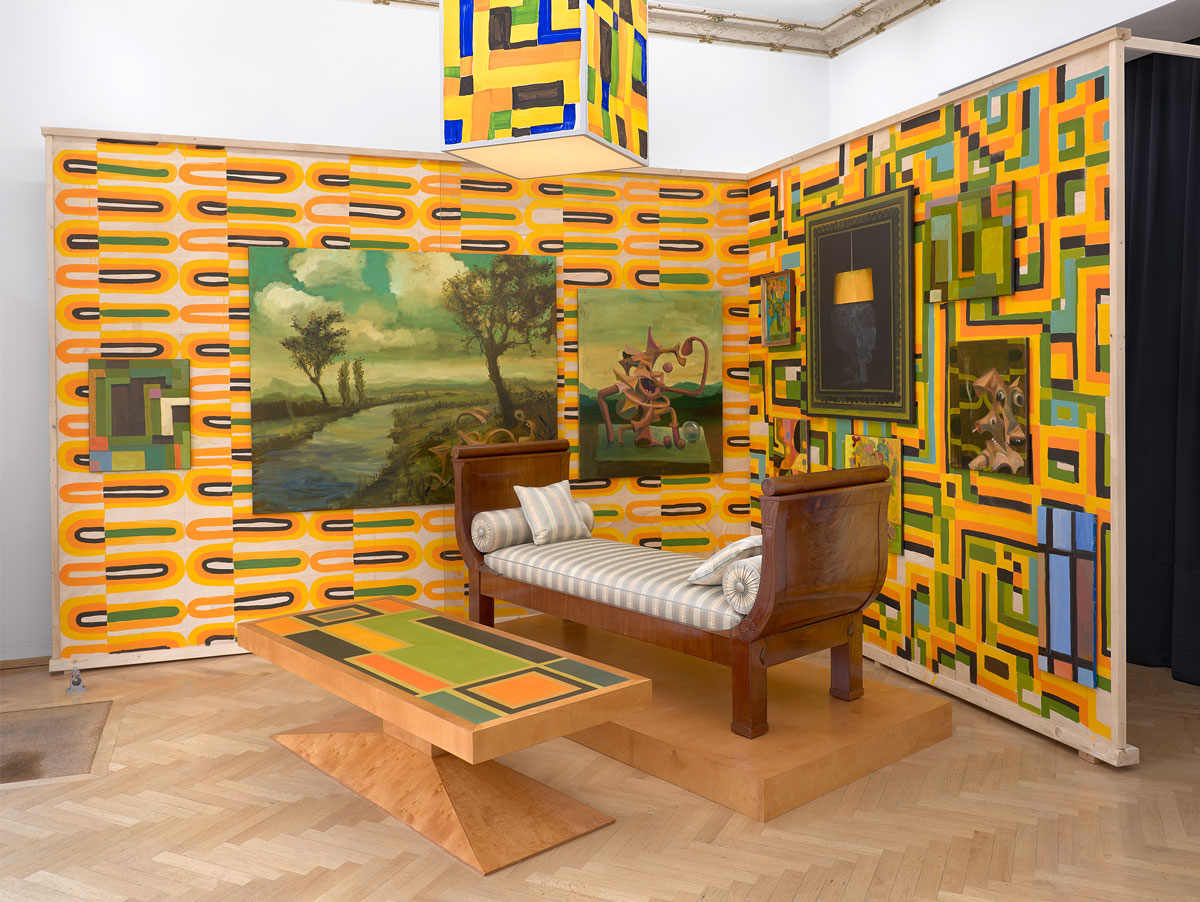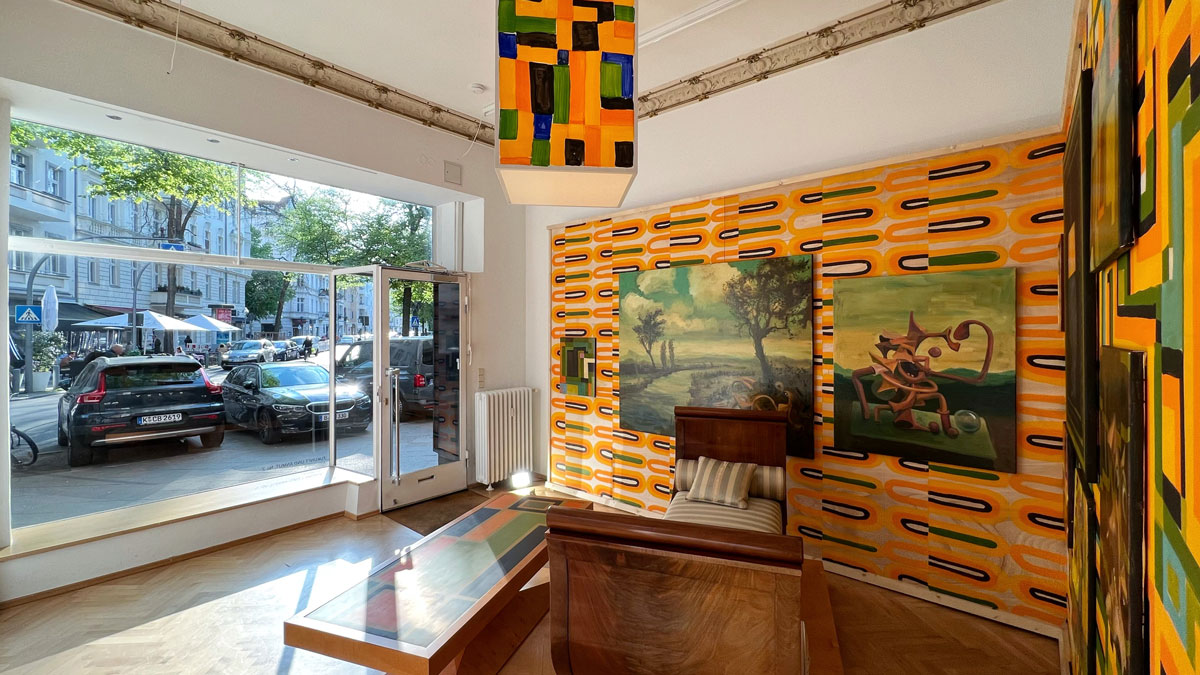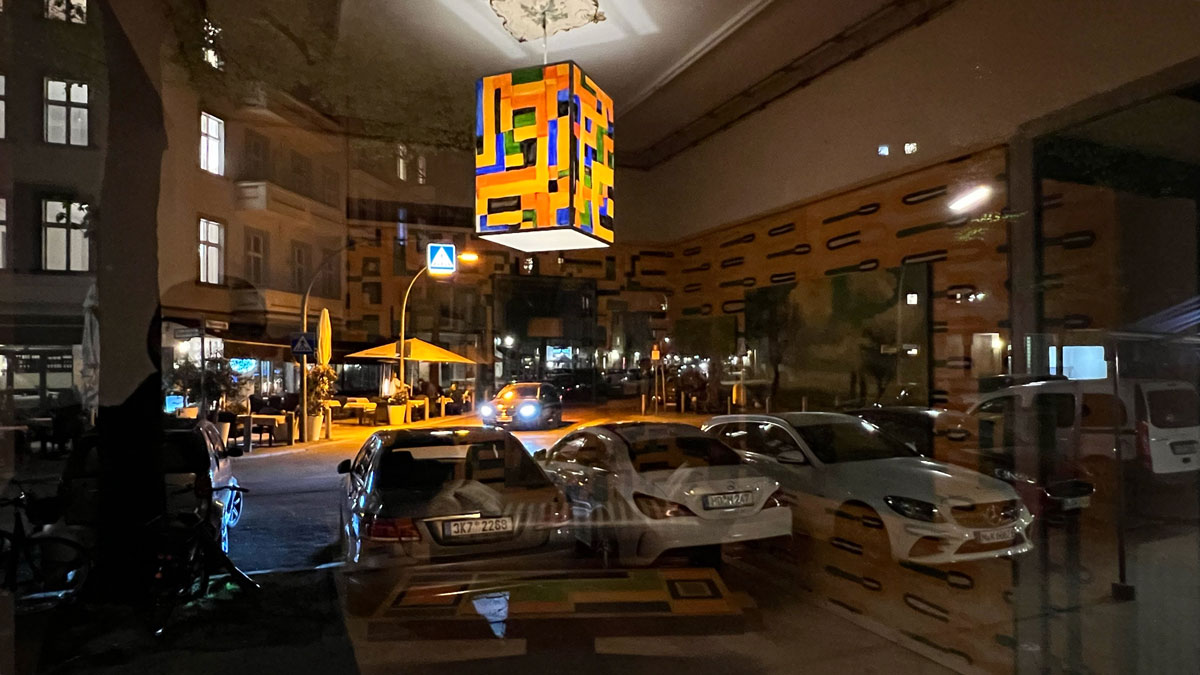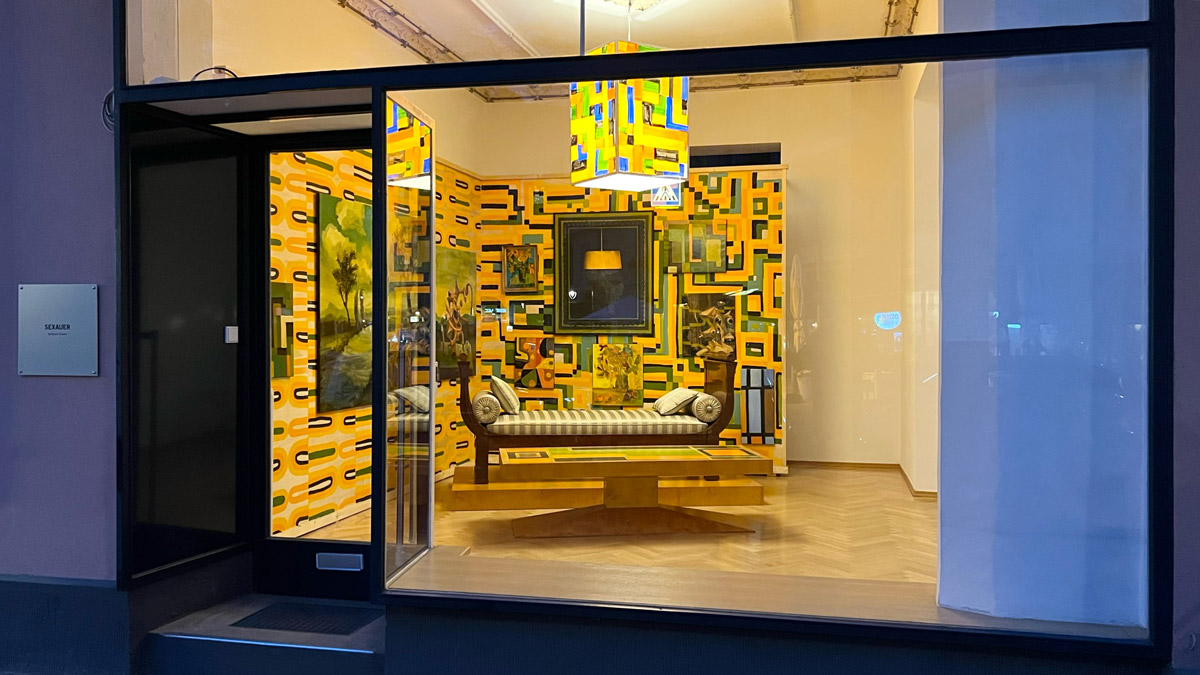



(english version below)
Zukunft und Anmut
Zum Gallery Weekend zeigt ANTON HENNING ein Interieur, das er eigens für den Showroom geschaffen hat. Interieur in Hennings Terminologie ist nicht unbedingt nur ein Gemälde. Es kann auch ein raumfüllender Salon sein, eine begehbare Installation, mit Gemälden, Plastiken, Lichtskulpturen und Mobiliar. Und so stehen denn auch im Showroom zwei zimmerhohe, mit einem bunten Muster bemalte, im rechten Winkel zueinanderstehende Holzwände, die einen offenen Raum bilden. An diesen Wänden hängen zehn eigens von Henning dafür angefertigte Gemälde. Vor den Wänden eine Chaiselongue auf einem Sockel, sowie vor dieser biedermeierlichen „Appropriation“ ein von Henning selbst entworfener und bemalter Tisch. Über allem eine Deckenlampe mit einem bemalten, tapetenartig gemusterten Schirm.
ZUKUNFT UND ANMUT, No.2 lautet der Titel der Ausstellung, deren einziger Gegenstand eben dieser neue Salon von Anton Henning ist, betitelt als Interieur 641. Ein Salon wie eine Bühne. Aber warum trägt dieser Salon die Zukunft und die Anmut im Titel? Warum Zukunft? Warum Anmut? Welches Stück wird hier gespielt?
Nach Friedrich Schiller ist Anmut eine Schönheit, die vom Subjekt ausgeht und sich vor allem in der Bewegung zeigt. Voraussetzung von Bewegung aber ist Freiheit. Und somit ist diese auch Voraussetzung für die Anmut. Ohne Freiheit keine Anmut. Das wussten schon die Vorsokratiker. Mit der Zukunft verhält es sich übrigens ebenso: Ohne Freiheit keine Zukunft.
Freiheit als Grundlage für Zukunft und Anmut. Dazu scheint der Salon zunächst in einem Widerspruch zu stehen. Ein Salon mit einer Chaiselongue! Man denkt an Biedermeier und Restauration. Gerade in Berlin. An den Rückzug des Bürgertums ins Private. Und vielleicht klingt dies ja auch an. Hatte sich Deutschland nicht auf die Chaiselongue gelegt, und vielleicht sogar halb Europa? Die Zimmer geheizt mit billigem Öl, obwohl man wissen konnte, dass Putin kalt kalkulierte? Diese Zeit scheint vorbei. Der Krieg ist zurückgekehrt nach Europa. So kann der Salon auch als Sinnbild für unsere Bequemlichkeit gelesen werden, in einer Zeit vor dem Krieg, in den Jahrzehnten nach dem „Ende der Geschichte“. Betrachtet man die Farben des Interieurs, fällt einem auf: schwarze, gelbe, grüne, rote und sogar ein paar blaue Töne. Wenn das nicht auch eine politische Farbenlehre ist! Ein kleines Salonparlament.
Als Symbol ist der Salon durchaus ambivalent. Er steht nicht ausschließlich für Restauration. Denn er war ja auch ein – wenn auch kleiner – Raum der Freiheit inmitten einer repressiven Außenwelt. Der Salon ermöglichte eine begrenzte Freiheit. Da er aber klein und begrenzt war, lud er auch zur Trägheit ein. Wenn er dann auch noch bequem eingerichtet war (Chaiselongue!), verführte er zu Bequemlich– und Bewegungslosigkeit. Ohne Bewegung aber keine Anmut, wie wir von Schiller wissen.
Trotz dieser möglichen Begrenzungssymbolik bedeuten die Salons für Henning vor allem Freiheit. Künstlerische Freiheit. Denn hier kann er alles selbst und autonom gestalten. Nicht nur ein einzelnes Bild. Auch Möbel, Teppiche, Plastiken und Licht. Dazu nicht weniger als zehn Bilder! Kuratiert und gehängt von ihm allein. Die uneingeschränkte künstlerische Kontrolle und damit die Freiheit von fremden Vorgaben. Die Schaffung einer eigenen Welt voller Anmut. In der man sich bewegen kann: eine Bedingung der Zukunft.
Postscriptum: Ein Gemälde von Henning ist auch Nukleus der parallel stattfindenden Gruppenausstellung SHATTERED – transformations of cubism, die bei SEXAUER in der Ausstellungshalle in Weißensee anhand zeitgenössischer Malerei Transformationen des Kubismus untersucht, sowie die in jener Malerei dargestellten Menschenbilder. Gleichzeitig zeigt Henning in der Galerie Haas, fünf Gehminuten vom Showroom entfernt, eine weitere Ausstellung. Ebenfalls ein Salon. Ein Raum der Freiheit. Will heißen ZUKUNFT UND ANMUT, No.1.
Future and grace
At Gallery Weekend, ANTON HENNING is showing an interior he created especially for the Showroom. Interior in Henning’s terminology is not necessarily just a painting. It can also be a room-filling salon, a walk-in installation with paintings, sculptures, light sculptures and furniture. And so there are two room-high wooden walls in the showroom, painted with a colourful pattern and standing at right angles to each other, forming an open space. On these walls hang ten paintings specially made by Henning. In front of the walls, a chaise longue on a pedestal, and in front of this Biedermeier “appropriation”, a table designed and painted by Henning himself. Above everything, a ceiling lamp with a painted, wallpaper-like patterned shade.
ZUKUNFT UND ANMUT, No.2 is the title of the exhibition whose sole object is precisely this new salon by Anton Henning, the interior 641 sketched above. A salon like a stage. But why does this salon bear the future and grace in its title? And why the future? Why grace? What play is being performed here?
According to Friedrich Schiller, grace is a beauty that emanates from the subject and manifests itself above all in movement. The prerequisite for movement, however, is freedom. And therefore this is also a requirement for grace. Without freedom there is no grace. The pre-Socratics already knew that. The same with the future: without freedom no future.
Freedom as the basis for future and grace. At first glance, the salon seems to contradict this. A salon with a chaise longue! One thinks of Biedermeier and the Restoration. Especially in Berlin. Of the bourgeoisie’s retreat into the private sphere. And perhaps this is what comes to mind. Didn’t Germany lie down on the chaise longue, and perhaps even half of Europe? Although climate change had been common knowledge for thirty years? The rooms heated with cheap gas, although one could know that Putin was calculating cold. The war has returned to Europe. So the salon can also be read as a symbol of our laziness, in the time before Corona and the Ukraine War, in the three decades after the “end of history”. Looking at the colours of the interior, one notices: black, yellow, green, red and even a few shades of blue. If that’s not a political colour scheme too! A small salon parliament.
As a symbol, the salon is quite ambivalent. It does not stand exclusively for restoration. Because it was also a space – though a small one – of freedom in the midst of a repressive outside world. The salon allowed for limited freedom. But because it was small and limited, it also invited indolence. If it was also comfortably furnished (chaise longue!), it seduced comfort and immobility. Without movement, however, there is no grace, as we know from Schiller.
Despite this possible symbolism of limitation, for Henning the salons meant above all freedom. Artistic freedom. Because here he can create everything himself and autonomously. Not just a single painting. Also furniture, carpets, sculptures and light. And no fewer than ten pictures! Curated and hung by him alone. Total artistic control and thus freedom from outside guidelines. The creation of a world of its own, full of grace. In which one can move: a condition of the future.
Postscriptum: A painting by Henning is also the nucleus of the group exhibition SHATTERED – transformations of cubism, which is taking place at the same time at SEXAUER in the exhibition hall in Weißensee and examines transformations of cubism on the basis of contemporary painting, as well as the images of people depicted in that painting. At the same time, Henning is showing another exhibition at Galerie Haas, just a five-minute walk from the showroom. Also a salon. A space of freedom. It’s called FUTURE AND GRACE, No.1.

